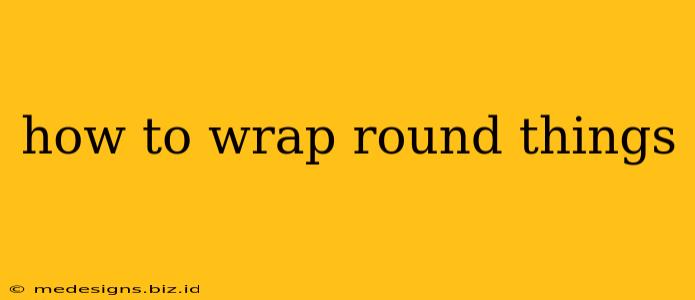Wrapping round objects can seem tricky, but with the right techniques and materials, it becomes a breeze. Whether you're wrapping presents, securing items for shipping, or creating decorative crafts, mastering these methods will save you time and frustration. This guide covers various techniques and materials for wrapping a wide range of round items.
Understanding Your Round Object
Before you start, assess your round item. Consider these factors:
- Size and Shape: Is it a perfect sphere, a cylinder, or something more irregular? The wrapping method will vary depending on the shape.
- Surface: Is the surface smooth or textured? A textured surface might require more padding or a different type of wrapping paper.
- Fragility: Is the item fragile? Extra padding will be essential to prevent damage during transport or handling.
Materials You'll Need
The materials you choose will depend on your project, but generally you'll need:
- Wrapping Paper or Fabric: Choose a material that suits your needs and aesthetic. Consider the weight and flexibility of the paper or fabric. For fragile items, use a thicker paper or fabric.
- Scissors or Cutter: Sharp scissors are crucial for clean cuts. A rotary cutter can be helpful for larger projects.
- Tape: Use strong tape that adheres well to your chosen wrapping material. Double-sided tape can be particularly useful for some techniques.
- Ribbon or String: For decorative purposes and to secure the wrapping.
- Padding (Optional): Bubble wrap, tissue paper, or packing peanuts are essential for protecting fragile items.
Wrapping Techniques for Round Objects
Here are a few popular techniques for wrapping round items:
Method 1: The "Overlapping" Method (For Cylinders and Irregular Shapes)
This method is ideal for cylindrical objects like candles or bottles, and also works well for irregularly shaped round items.
- Prepare the Item: Add padding if needed.
- Measure and Cut: Measure the circumference of the item and add extra for overlap. Cut a piece of wrapping paper accordingly. The length of the paper should be long enough to cover the entire height of the item, plus extra for tucking in.
- Wrap and Secure: Lay the paper flat, place the item in the center, and begin wrapping, overlapping the edges as you go. Secure with tape.
- Finishing Touches: Tuck in any loose ends and add ribbon or string for decoration.
Method 2: The "Spiral" Method (For Spheres and Cylinders)
This is a classic method suitable for spheres like balls or ornaments, and also works well for cylinders.
- Prepare the Item: Add padding if necessary.
- Start Wrapping: Begin at the top or bottom of the object and wrap the paper tightly in a spiral motion, overlapping each layer slightly.
- Secure and Finish: Secure the end with tape. Trim any excess paper and add decorative elements.
Method 3: The "Fabric Wrapping" Method (For Decorative and Gift Purposes)
Fabric wrapping provides an elegant and reusable alternative to paper.
- Choose Your Fabric: Select a fabric that complements the item being wrapped.
- Measure and Cut: Cut a piece of fabric large enough to completely cover the item, with extra for gathering and tying.
- Wrap and Tie: Wrap the fabric around the item, gathering it at the top and tying it securely with ribbon or string.
Tips for Success
- Practice Makes Perfect: Don't be discouraged if your first attempt isn't perfect. The more you practice, the better you'll become.
- Use a Cutting Mat: Protect your work surface by using a cutting mat.
- Get Creative: Experiment with different materials and techniques to find what works best for you.
- Consider the Occasion: The type of wrapping should complement the occasion and the item being wrapped.
By following these techniques and tips, you'll be able to master the art of wrapping round things and create beautifully presented gifts or securely packaged items. Happy wrapping!
